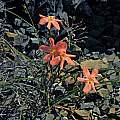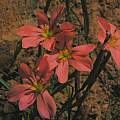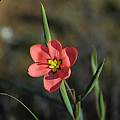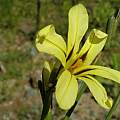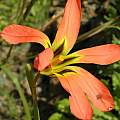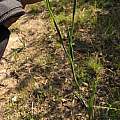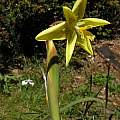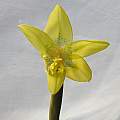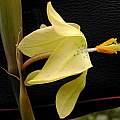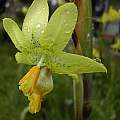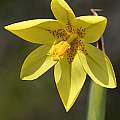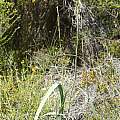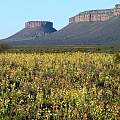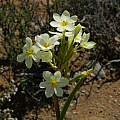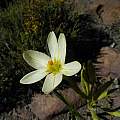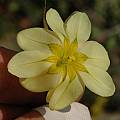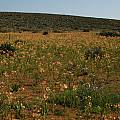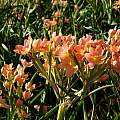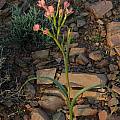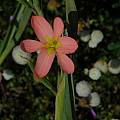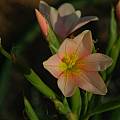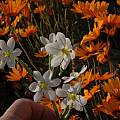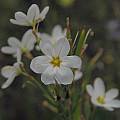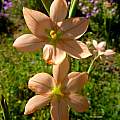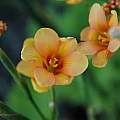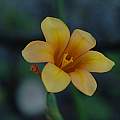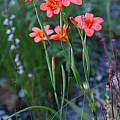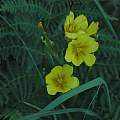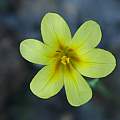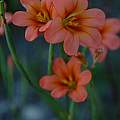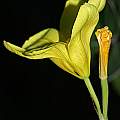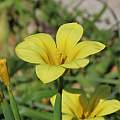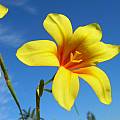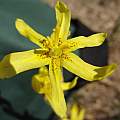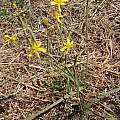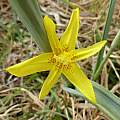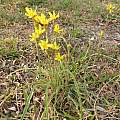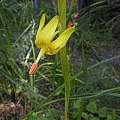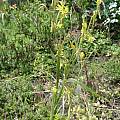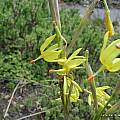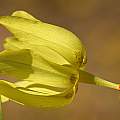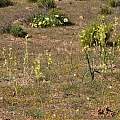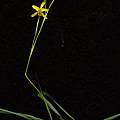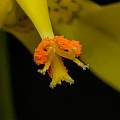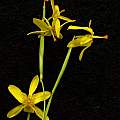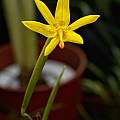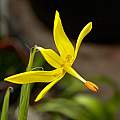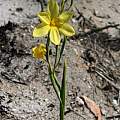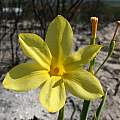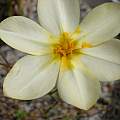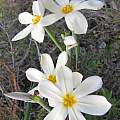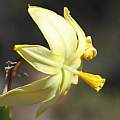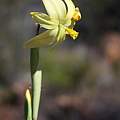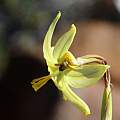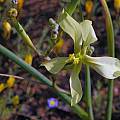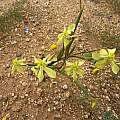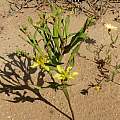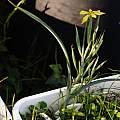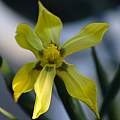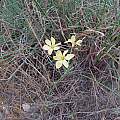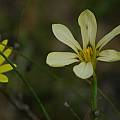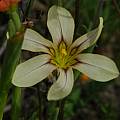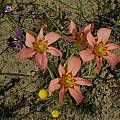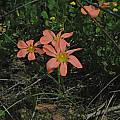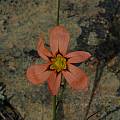The genus Moraea can be divided into five groups: Galaxia, Gynandriris, Hexaglottis, Homeria, and Moraea. Homeria which was once considered to be a separate genus in the Iridaceae family is now included in Moraea. There are about 32 species of this Moraea subgroup native to southern Africa. They have long narrow basal leaves, sometimes only one per corm and large yellow, pink, orange, or bicolor flowers with six fairly equal tepals. The leaves of some species can be poisonous and are avoided by sheep and cattle and can then multiply freely. Some species have a reputation of being weedy and they are not welcomed in Australia because of agricultural concerns. In the United States, five species in the Homeria group are classified by the federal government as "noxious weeds:" M. collina, flaccida, miniata, ochroleuca, and pallida. It is not legal to import them or transfer them between states without a permit. The plants are, though, allowed within California by the state government. Homerias are not very hardy so there is little danger of their becoming weedy in climates not to their liking, and even in mild climates like California they are not particularly aggressive in the garden. But it's probably wise to keep them away from open range-land. Although the flowers only last a day or two, some of the species produce flowers over a long period. Information and pictures of the other Moraea groups can be found by clicking on these groups or the Moraea group pages listed below or found in the Moraea index where all species are listed alphabetically.
Homeria subgroup species k-z are found on this wiki page.
Moraea karroica Goldblatt (syn. Homeria tricolor G.J.Lewis) is found in clay soils in renosterveld and karroid bush in the Roggeveld, northwest Cape, and the western Karoo. It has a single clasping leaf and salmon to deep pink flowers with a yellow center edged in red or purple. Seen in the Komsberg September 2006 and photographed by Mary Sue Ittner.
Moraea longistyla (Goldblatt) Goldblatt (syn. Homeria longistyla Goldblatt) grows in the Western Cape and the Karoo mountain center in a variety of soils. Plants are 15 to 30 cm high with yellow or salmon flowers and the claws forming a deep cup including the stamens. Flowering is August to September. Photos from iNaturalist taken by Nick Helme in August and September in the western Cape and shared under a CC BY-NC license.
Moraea marlothii (L.Bolus) Goldblatt (syn. Homeria marlothii L.Bolus) is tall plant with a wide long grey green leaf and yellow or salmon nodding flowers with green specks. It grows on sandstone rocks or heavy clay soils in the northwest Cape and the western Karoo. The corm gets to be rather large and I never had success getting it to bloom until I planted it in the ground. It seems much happier where it has more root room. The first two photos by Mary Sue Ittner, the next two from Dirk Wallace, and the last two photos were taken in habitat by Andrew Harvie in the Oorlogskloof Nature Reserve.
Moraea miniata Andrews (syn. Homeria miniata) (Andrews) Sweet is widespread (Namaqualand, Roggeveld, northwest, southwest, and southern Cape), growing mainly on clay slopes, renosterveld and karroid scrub. It has two or three linear leaves, usually salmon flowers, but sometimes yellow or white and is minutely speckled in the center. It is poisonous and has a number of ways of spreading (by cormlets in the leaf axils sometimes). It is banned in Australia and to be avoided in areas where it can thrive and become a problem. Photos by Mary Sue Ittner, Bob Rutemoeller, and Cameron McMaster were taken near Middelpos and Sutherland in the Roggeveld on IBSA trips in September of different years. One of the flowers had extra tepals.
Photos 1-2 from Bob Rutemoeller and Mary Sue Ittner of plants with white flowers blooming in Namaqualand September 2006. Photo 3 taken in Namaqualand by Cameron McMaster September 2011 shows the more usual color form.
Moraea ochroleuca (Salisb.) Drapiez (syn. Homeria ochroleuca) Salisb. found on rocky sandstone slopes in the northwest and the southwest Cape and blooming in spring has yellow, orange, or bi-colored flowers. It has a wide spreading tepal cup and an unpleasant smell. Photographs were taken September 2006 by Bob Rutemoeller, Mary Sue Ittner, and Rod Saunders near a back trail in the undeveloped part of Kirstenbosch National Botanical Garden that had burned previously.
The next two photos were taken in habitat by Andrew Harvie in Table Mountain National Park. The side view was taken on the Bridle Path, Table Mountain and the second on Lion's Head. The last photos were taken by Alan Horstmann.
Moraea pallida (Baker) Goldblatt (syn. Homeria pallida Baker) is widespread in southern Africa and is found in Namibia and Botswana and the Northern Cape, Orange Free State, Karoo, and Transvaal to the Natal midlands in South Africa. Growing from 10 to 40 cm, it has a solitary curved or erect leaf from 5-15 mm wide and yellow, occasionally pink, flowers with dark yellow in the center and green-speckled nectar guides. It flowers in spring at the end of a long, usually dry winter before the onset of the summer rainfall season. It is extremely toxic to stock. Photos from iNaturalist taken by Jane Trembath near Benoni, Gauteng, South Africa in Korsman Bird Sanctuary and near Aubrey Ritz Park in September and shared under a CC BY-NC license
Moraea pendula (Goldblatt) Goldblatt (syn. Homeria pendula) Goldblatt is found in the Kamiesberg, Namaqualand, South Africa, in moist places at the base of rocks and near streams; the flowers are yellow, tepals reflexed, anthers red. Photo #1 was taken by Bob Rutemoeller. Photos #2-3 were contributed by the UC Botanical Garden. Photos 4-5 Andrew Harvie.
Photographs by David Pilling.
Time lapse video by David Pilling of Moraea pendula flowers opening as the day warms up. Taken between 11:30 am and 5.30 pm on Tuesday 29th April 2014.
Moraea pyrophila Goldblatt (syn. Homeria galpinii L.Bolus) grows in sandstone areas, where it tends to bloom after fires. Photos taken at Farm 215 by by Maarten Groos.
Moraea radians (Goldblatt) Goldblatt (syn. Homeria radians (Goldblatt) Goldblatt) grows in clay soils in renosterveld in the southwest cape and flowers late winter to spring. It has a single trailing linear leaf and cream flowers with a yellow center. The first photo was taken by Alan Horstmann. The second photo from iNaturalist was taken by Nick Helme in the Western Cape and shared under a CC BY-NC license.
Moraea reflexa Goldblatt (syn. Homeria hantamensis Goldblatt & J.C.Manning) grows on rocky doleritic soils in the western Karoo on the Hantamsberg. It ranges in size from 17 to 110 cm with a single, linear, channeled, glaucous, broad and clasping leaf and has pale yellow flowers with dark spots near the base of the tepals. Flowers are nodding on recurved pedicels. Flowering is October-November. Photos were taken by Alan Horstmann in October, Hantam Mountain, Calvinia.
Moraea schlechteri (L.Bolus) Goldblatt (syn. Homeria schlechteri L.Bolus) has two lanceolate leaves with a broad sheathing base. It has small yellow flowers grouped at the ends of the stems and is found in Namaqualand in flat sandy places. The first two photos were taken September 2007 in Namaqualand by Mary Sue Ittner. Photos 3-4 were taken by Cameron McMaster September 2011 in Namaqualand. Other two photos are of a cultivated form with dark nectar guides, taken in California by Michael Mace.
Moraea umbellata Thunb. (syn. Homeria umbellata (Thunb.) G.J.Lewis and Rheome umbellata (Thunb.) Goldblatt) is found on seasonally wet sandstone flats and plateaus in the western Cape. It grows to 45 cm high with a stem branched above the leaves and the flowers arranged on the stalk so they look like an umbel. Flowers are pale yellow and appear September to November making this one of the later species in this group to bloom in the wild. The photo below was taken by Margaret Fox near Ceres.
Moraea vallisbelli (Goldblatt) Goldblatt (syn. Homeria vallisbelli Goldblatt) is found in the northwest Cape growing in rocky sandstone soils. It has a single linear channeled leaf and is yellow, salmon, or pink with darkly outlined yellow nectar guides. Photos by Mary Sue Ittner were taken September 2006 near Nieuwoudtville.
Galaxia - Gynandriris - Hexaglottis - Homeria a-j - Moraea group a - Moraea group b - Moraea group c-e - Moraea group f - Moraea group g-i - Moraea group j-m - Moraea group n-r - Moraea group s - Moraea group t - Moraea group u-v - Moraea hybrids - Moraea index
